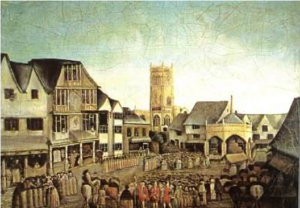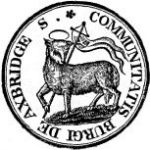Articles written for “Catch This” June 2020
Axbridge Lady Day Fair
Lady Day (25th March) was widely observed in England and, until 1752, when the government adopted the Gregorian calendar it was also New Year’s Day and marked the beginning of the agricultural year. Agricultural tenancies were normally for one year running from Lady Day and the Fair was also a hiring fair for agricultural labourers and domestic workers.

The Fair would have been one of the highlights of the year for many people and one can imagine that they were lively affairs. In 1805 an article in the Gentleman’s Magazine (vol. 75 issue 1) states that the Axbridge fair was “attended by an immense concourse of servants of both sexes. The fair usually continues for 2 or 3 days; and many of the fair fille-de-chambres, dairy maids, and even fat cooks and greasy scullion wenches are so civilly greeted by their amorous swains, that this fair is much business for the county justices and their clerks, parish officers and midwives.”Lady Day
In 1839 the Taunton Courier and Western Advertiser (03.04.1839) reported that “The pleasure fair was plentifully supplied with the happy countenances of the county folk, looking and harkening in to the various stories told by the persons who begin with ‘walk up ladies and gentlemen, and see the most wonderful of all wonders etc.’ and supplying themselves with new shoes and their sweethearts with ribbons and other finery.”
Of course then, as now, such events also attracted crime and by the mid 19th century concern was being expressed in the newspapers. This report (Taunton Courier and Western Advertiser 03.04.1850) concludes that “for the size of the town, there is no other place in the kingdom so much infested by pickpockets and gamblers of the lowest description as this during the fair” and the Bath Chronicle and Weekly Gazette (01.04.1852) said that “the fair has long been notorious for the gross licence which reigns among the lower classes who collect on these occasions.”
In the same year the Wells Journal (16 October 1852) reports that, “the pleasure part of the Axbridge Lady Day Fair has degenerated into a positive nuisance, of which the respectable neighbours have loudly and unanimously complained. In consequence a movement, of which the initiative was taken by our esteemed and influential townsmen Peter Fry and Henry Symonds Esq, has been made to abolish it.”
Clearly this failed and the Fair continued, albeit in a different form. I’m sure many readers will have good memories of attending some of them. Hopefully not causing a nuisance!!
Elizabeth Friend
In writing an article about the Axbridge Lady Day Fair I found the following connection to Billy Butlin (1899-1980): Apparently his parents met at a travelling fair in Gloucester. After some years and after her failed marriage his mother travelled around summer fairs in her caravan running a gingerbread stall for her brother Marshall Hill. In 1921 Billy joined his uncles in Bristol and, with their assistance, set up a small hoopla stall at a cost of 30 shillings. His first fair was in Axbridge and apparently business was good and he made £10 clear profit on the day. He went on to run stalls at fairs for several years before starting the holiday camps. You can read the rest of his story on www.butlins-memories.com.
In 1949 according to an item in the Well Journal (2 September 1949) he donated £25 towards the purchase of a playing field in Axbridge.
A Tale of Peas, Beans and other assorted crops
Did you know that Axbridge was once famous for growing early peas? In 1805 an article said the following:
“The warm situation of [Axbridge] renders it peculiarly adapted for the cultivation of early vegetables; the town and parish being situate, as it were, in a dwell, which forms a kind of amphitheatre ….. Green peas in particular are here to be had as early in the season of any place in the Kingdom; and they are frequently sent to Bristol, Bath and sold at 16s* and 18s per peck*; and the premium given by the Corporation of Bristol for the most early peas brought to market is generally carried by the Axbridge gardeners.
The walks near the town in the Spring season are rendered very pleasant, from the variety of the crops which are raised in the fields adjoining by the gardeners (or, as they are here called, cropers); where may be seen at one view a great variety of culinary plants, proper for the kitchen garden, disposed in large beds and ridges, interspersed with ridges of wheat, barley, beans, peas, oats etc.
*Note: a peck was approx. 12lbs and in 1805, 16 shillings was worth approx. £37 today and was the equivalent of 5 days wages for a skilled tradesman
